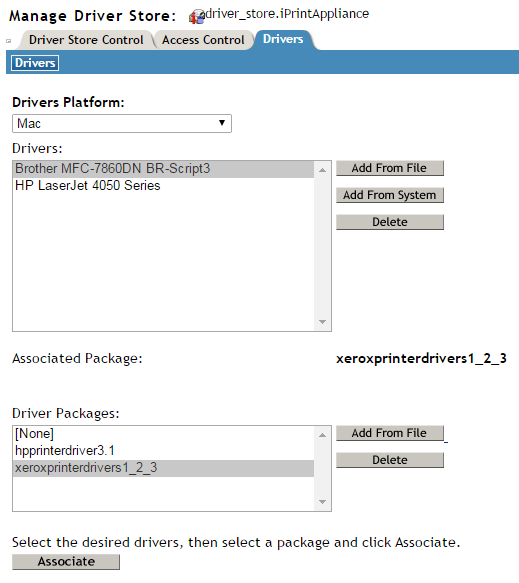4.5 Managing Printer Drivers
A printer driver or PostScript Printer Description (PPD) file is software that directly supports a physical printer, enabling it to carry out its functions.
Hardware vendors develop printer drivers and PPD files, which are specific to each printer. Most printers require different printer drivers for each operating system they interact with. You can use iManager to view a list of printer drivers and PPD files you have uploaded to the Driver Store. On Windows Vista, Windows 8, Windows 8.1, and Windows 10 platforms, you can also upload printer drivers by using a command line option. For more information, see Section 4.9, Implementing iPrint by Using the Command Line. You can add printer drivers and PPD files from diskettes, CDs, and the workstation operating system.
The Driver Store daemon must be running in order to add printer drivers, and the iPrint Client must be installed on a Linux or Windows workstation. To install the client, go to http://dns_name or IP_address/ipp and click the Install iPrint Client link. For more information on installing the client, see Section 10.0, OES iPrint Advanced on Client Workstations. For a review of supported browsers and driver upload operations, see Section B.2, Supported Browsers for the iPrint Plug-In and iManager.
To add printer drivers to the Driver Store:
-
In iManager, click iPrint > Manage Driver Store.
Figure 4-1 iManager

-
Specify the name of the iPrint Driver Store to which you want to add printer drivers.
-
Select the Drivers tab.
-
Use the Drivers Platform drop-down list to select the client platform for which you want toupload the printer driver.
-
Do one of the following:
-
Click Add from File to add printer resources from a printer driver .inf file or PPD file.
Mac: The standard file format is PPD (Postscript Printer Description) file.
Windows: The standard file format is .inf file.
-
Click Add from System to add drivers from the workstation where you are running iManager.
The drivers installed on your workstation are made available to be uploaded to the Driver Store. You can upload only drivers for the platforms installed on your workstation.
-
-
Select a driver, then click OK.
-
(Conditional) If the client platform is Mac, new options are available as follows:

Associated Driver Package: Displays the driver package, if any, associated with the selected drivers. This is the dependent package for the driver and is installed with the printer. This option is available only on a Mac machine.
-
Perform one of the following actions:
-
Click Add from File to add printer driver package to the list from a .pkg or .dmg file that you obtain from the printer vendor.
Figure 4-2 Re-authentication for uploading associated driver packages on MAC

-
Browse and select the package from the Driver Packages list.
-
Enter your iManager Administrator Credentials and click Upload.
-
Click Associate. This associates the selected driver to the package. When a user installs the printer, the driver and its associated files from this package are installed on the workstation. If the dependent files are missing, the printer installation fails.
-
To disassociate a driver from the package, select the driver and select None from the Driver Packages list and click Associate. The driver is no longer associated to any package.
-
-
-
-
Click OK to save your changes.
or
Click Cancel to exit without saving your changes.
-
Click Refresh to refresh the screen and display the changes you just made.
If you need to install an iPrint printer but cannot use a web browser, you can use the iprntcmd.exe command at a DOS prompt. For more information, see Using iprntcmd.exe to Install iPrint Printers. You can also install driver files from a Linux console prompt by using the iprntcmd command. For more information, see Section 4.10, Using iprntcmd on Linux and Macintosh.
To delete printer drivers from the Driver Store:
-
In iManager, click iPrint > Manage Driver Store.
-
Select the Drivers tab.
-
Read the list of existing printer drivers displayed in the Current Drivers panel.
-
Select a driver, then click Delete.
-
Click OK to save your changes
or
Click Cancel to exit without saving your changes.
-
Click Refresh to refresh the screen and display the changes you just made.